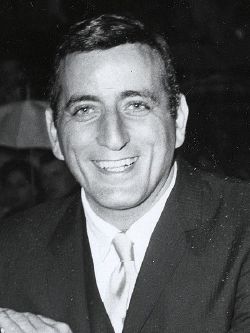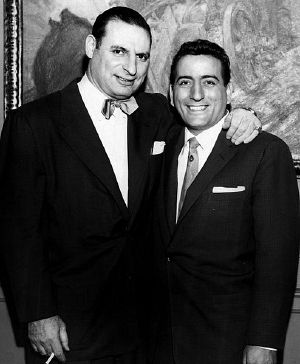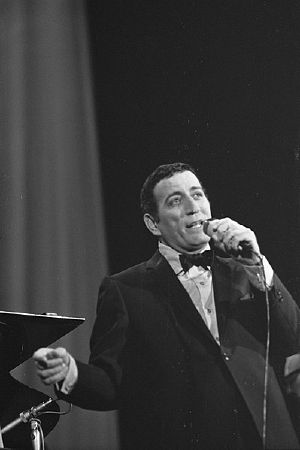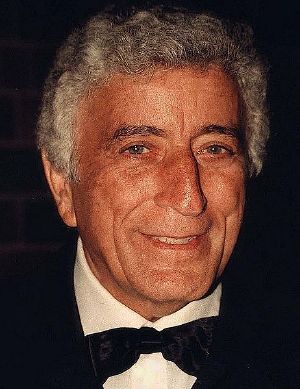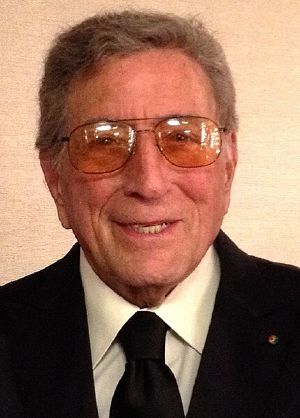Tony Bennett
Anthony Dominick Benedetto (August 3, 1926 – July 21, 2023), known professionally as Tony Bennett, was an American jazz and traditional pop singer. He received numerous accolades, including 20 Grammy Awards, a Lifetime Achievement Award, and two Primetime Emmy Awards, and was a Kennedy Center Honoree. He sold more than 50 million records worldwide and earned a star on the Hollywood Walk of Fame.
He had his first number-one popular song with "Because of You" in 1951. Several popular tracks such as "Rags to Riches" followed in early 1953. He then refined his approach to encompass jazz singing. In 1962, Bennett recorded his signature song, "I Left My Heart in San Francisco." After a downturn during the early rock and roll era when he struggled to record contemporary songs, Bennett's career rebounded and he continued to create popular and critically appraised work into the twenty-first century. In particular, his collaboration with Lady Gaga, which began with the album Cheek to Cheek (2014) led to renewed acclaim late in his career. With the release of the duo's second album, Love for Sale (2021), Bennett broke the Guinness World Record for the oldest person to release an album of new material, at the age of 95 years and 60 days.
Despite having been diagnosed with Alzheimer's disease in 2016, he continued to record, tour, and perform until his final performances, with Lady Gaga, in August 2021 at Radio City Music Hall.
Life
Anthony Dominick Benedetto was born on August 3, 1926, at St. John's Hospital in Long Island City, Queens, in New York City.[1] He was the son of grocer John Benedetto and seamstress Anna (née Suraci). John had emigrated in 1906 from Podargoni, a rural eastern district of the southern Italian city of Reggio Calabria:
Tony Bennett's paternal grandfather, Giovanni Benedetto, grew up in the village of Podargoni, above Reggio Calabria. The family were poor farmers, producing figs, olive oil, and wine grapes. His mother's family, the Suracis, also farmed in Calabria. Neither side of the family could read or write.[2]
Anna had been born in the U.S. shortly after her parents also emigrated from the Calabria region in 1899. Other relatives came over as well as part of the mass migration of Italians to America (1880-1914).[2]
Tony grew up with an older sister, Mary, and an older brother, John Jr. With a father who was ailing and unable to work, the children grew up in poverty.[3] John Sr. instilled in his son a love of art and literature, and a compassion for human suffering,[2] but died when Tony was ten years old.[3]
Bennett grew up listening to Al Jolson, Eddie Cantor, Judy Garland, and Bing Crosby, as well as jazz artists such as Louis Armstrong, Jack Teagarden, and Joe Venuti. His uncle Dick was a tap dancer in vaudeville, giving him an early window into show business,[4] and his uncle Frank was the Queens borough library commissioner. By age 10 he was already singing, and performed at the opening of the Triborough Bridge, standing next to Mayor Fiorello La Guardia who patted him on the head.[2]
Drawing was another early passion of his;[3] he became known as the class caricaturist at P.S. 141 and anticipated a career in commercial art.[2] He began singing for money at age 13, performing as a singing waiter in several Italian restaurants around his native Queens.[5]
Bennett attended New York's School of Industrial Art, later the High School of Art and Design, where he studied painting and music and would later appreciate their emphasis on proper technique.[2] But he dropped out at age 16 to help support his family, working as a copy boy and runner for the Associated Press in Manhattan and in several other low-skilled, low-paying jobs.[2] He mostly set his sights on a professional singing career, returning to performing as a singing waiter, playing and winning amateur nights all around the city, and enjoying a successful engagement at a Paramus, New Jersey, nightclub.[5]
Military service
Benedetto was drafted into the United States Army in November 1944, during the final stages of World War II. He did basic training at Fort Dix and Fort Robinson as part of becoming an infantry rifleman. Benedetto ran afoul of a sergeant from the South who disliked the Italian from New York City; heavy doses of KP duty or BAR cleaning resulted.[1] Processed through the huge Le Havre replacement depot, in January 1945, he was assigned as a replacement infantryman to the 255th Infantry Regiment of the 63rd Infantry Division, a unit filling in for the heavy losses suffered in the Battle of the Bulge. He moved across France and later into Germany.[3] As March 1945 began, he joined the front line of what he would later describe as a "front-row seat in hell."[1]
As the German Army was pushed back to its homeland, Benedetto and his company saw bitter fighting in cold winter conditions, often hunkering down in foxholes as German 88 mm guns fired on them. At the end of March, they crossed the Rhine and entered Germany, engaging in dangerous house-to-house, town-after-town fighting to clean out German soldiers; during the first week of April, they crossed the Kocher River, and by the end of the month reached the Danube.[1] During his time in combat, Benedetto narrowly escaped death several times. The experience made him a pacifist;[3] he would later write, "Anybody who thinks that war is romantic obviously hasn't gone through one,"[1] and later say, "It was a nightmare that's permanent. ... I just said, ‘This is not life. This is not life.’"[6] At the war's conclusion he was involved in the liberation of the Kaufering concentration camp, a subcamp of Dachau, near Landsberg, where some American prisoners of war from the 63rd Division had also been held. He later wrote:
The main thing I got out of my military experience was the realization that I am completely opposed to war. Every war is insane, no matter where it is or what it’s about. Fighting is the lowest form of human behavior. It’s amazing to me that with all the great teachers of literature and art, and all the contributions that have been made on this very precious planet, we still haven’t evolved a more humane approach to the way we work out our conflicts. Although I understand the reasons why this war was fought, it was a terrifying, demoralizing experience for me. I saw things no human being should ever have to see.[7]
Benedetto stayed in Germany as part of the occupying force but was assigned to an informal Special Services band unit that would entertain nearby American forces.[3] Subsequently, he sang with the 314th Army Special Services Band under the stage name Joe Bari (a name he had started using before the war, chosen after the city and province in Italy, and as a partial anagram of his family origins in Calabria).[1]
Marriages
On February 12, 1952,[2] Bennett married Ohio art student and jazz fan Patricia Beech, whom he had met the previous year after a nightclub performance in Cleveland.[8] Two thousand female fans dressed in black gathered outside the ceremony at St. Patrick's Cathedral in Manhattan, New York, in mock mourning.[9] The couple had two sons, D'Andrea (Danny, b. 1954) and Daegal (Dae, b. 1955).[2] Bennett and Patricia separated in 1965, their marriage a victim of Bennett's spending too much time on the road, among other factors.[9] In 1969, Patricia sued him for divorce on grounds of adultery and desertion.[10] In 1971, their divorce became official.[11]
Bennett had become involved with aspiring actress Sandra Grant while filming The Oscar in 1965. The couple lived together for several years and on December 29, 1971, they quietly married in New York. They had two daughters, Joanna (b. 1970) and Antonia (b. 1974),[2] and moved to Los Angeles. The two were married until 1983.[12]
In the late 1980s, Bennett entered into a long-term romantic relationship with Susan Crow, a former New York City schoolteacher. Bennett and Crow founded Exploring the Arts, a charitable organization dedicated to creating, promoting, and supporting arts education. At the same time, they founded (and named after Bennett's friend) the Frank Sinatra School of the Arts in Queens, a public high school dedicated to teaching the performing arts. On June 21, 2007, Bennett married Crow in a private civil ceremony in New York that was witnessed by Mario Cuomo, the former governor of New York.[13]
Illness and death
In February 2021, Bennett revealed that he had been diagnosed with Alzheimer's disease in 2016, though he continued to perform and record until the COVID-19 pandemic in early 2020. Bennett's twice-weekly singing practices are thought to have kept his brain stimulated and spared him from symptoms such as disorientation, depression, and a detachment from reality.[14] His neurologist noted that, prior to the pandemic, the singer's touring schedule "kept him on his toes and also stimulated his brain in a significant way".[15] Bennett recorded tracks with Lady Gaga from 2018 until early 2020 for their 2021 album Love for Sale, despite at times being "lost and bewildered" during recording sessions.[14]
Due to the slow progression of his illness, he continued to record, tour, and perform until his retirement from concerts due to physical challenges, which was announced after his final performances on August 3 and 5, 2021, at Radio City Music Hall. In announcing Bennett's retirement, Danny Bennett stated that the Alzheimer's was mainly affecting his father's short-term memory and that he would often forget he had just performed after a concert; his long-term memory remained intact and he could still fully remember all the lyrics to his repertoire when performing.[16]
Bennett died at his home in New York City on July 21, 2023, seven years after his Alzheimer's diagnosis. His family said he kept singing to the end, singing "Because of You" the day before his death.[17]
Bennett was interred in a private ceremony alongside his parents at Calvary Cemetery, Queens.[18]
Musical Career
Bennett released over 70 albums during his career, almost all for Columbia Records. The biggest selling of these in the U.S. were I Left My Heart in San Francisco, MTV Unplugged: Tony Bennett, and Duets: An American Classic, all of which went platinum for shipping one million copies. Eight other albums of his went gold in the U.S., including several compilations. Bennett also charted over 30 singles during his career, with his biggest hits all occurring during the early 1950s, and none charting between 1968 and 2010.
Beginnings
Upon his discharge from the Army and return to the States in 1946, Benedetto studied at the American Theatre Wing on the GI Bill.[19] He was taught the bel canto ("beautiful music") singing discipline, which emphasizes a light, flowing technique.[20] He continued to perform wherever he could, including while waiting tables.[3] Based upon a suggestion from a teacher at the American Theatre Wing, he developed an unusual approach that involved imitating, as he sang, the style and phrasing of other musicians—such as that of Stan Getz's saxophone and Art Tatum's piano—helping him to improvise as he interpreted a song.[21] He made a few recordings as Joe Bari in 1949 for a small outfit called Leslie Records, but they failed to sell.[8]
In 1949, Pearl Bailey recognized Benedetto's talent and asked him to open for her in Greenwich Village.[5] She had invited Bob Hope to the show. Hope decided to take Benedetto on the road with him and, not liking the stage name "Joe Bari," shortened his name to Tony Bennett.[8]
1951–1959: First successes
In 1950, Bennett cut a demo of "Boulevard of Broken Dreams" and was signed to the major label Columbia Records by Mitch Miller.[19] Warned by Miller not to imitate Frank Sinatra[4] (who was just then leaving Columbia), Bennett began his career as a crooner of commercial pop tunes. His first big hit was "Because of You," a ballad produced by Miller with a lush orchestral arrangement from Percy Faith. It started out gaining popularity on jukeboxes, then reached number one on the pop charts in 1951 and stayed there for ten weeks, selling over a million copies.[8] This was followed to the top of the charts later that year by a similarly styled rendition of Hank Williams's "Cold, Cold Heart," which helped introduce Williams and country music in general to a wider, more national audience. The Miller and Faith tandem continued to work on all of Bennett's early hits. Bennett's recording of "Blue Velvet" was also very popular and attracted screaming teenage fans at concerts at the famed Paramount Theater in New York (Bennett did seven shows a day, starting at 10:30 a.m.)[22] and elsewhere.
A third number-one came in 1953 with "Rags to Riches". Unlike Bennett's other early hits, this was an up-tempo big band number with a bold, brassy sound and a double tango in the instrumental break. Later that year, the producers of the upcoming Broadway musical Kismet had Bennett record "Stranger in Paradise" as a way of promoting the show during a New York newspaper strike. The song reached the top, the show was a hit, and Bennett began a long practice of recording show tunes.[1] "Stranger in Paradise" was also a number-one hit in the United Kingdom a year and a half later.[23]
Once the rock and roll era began in 1955, the dynamic of the music industry changed and it became harder and harder for existing pop singers to do well commercially. Nevertheless, Bennett continued to enjoy success, placing eight songs in the Billboard Top 40 during the latter part of the 1950s, with "In the Middle of an Island" (which he vehemently hated) reaching the highest at number nine in 1957.[24]
For a month in August–September 1956, Bennett hosted an NBC Saturday night television variety show, The Tony Bennett Show, as a summer replacement for The Perry Como Show. Patti Page and Julius La Rosa had in turn hosted the two previous months, and they all shared the same singers, dancers, and orchestra.[25] In 1959, Bennett would again fill in for The Perry Como Show, this time alongside Teresa Brewer and Jaye P. Morgan as co-hosts of the summer-long Perry Presents.[26]
1954–1965: A growing artistry
In 1954, the guitarist Chuck Wayne became Bennett's musical director. Bennett released his first long-playing album in 1955, Cloud 7, which showed Bennett's leanings towards jazz. In 1957, Ralph Sharon became Bennett's pianist, arranger, and musical director, replacing Wayne. Sharon told Bennett that a career singing "sweet saccharine songs like 'Blue Velvet'" would not last long, and encouraged Bennett to focus even more on his jazz inclinations.[4]
The result was the successful 1957 album The Beat of My Heart. It featured well-known jazz musicians such as Herbie Mann and Nat Adderley, with a strong emphasis on percussion from the likes of Art Blakey, Jo Jones, Latin star Candido Camero, and Chico Hamilton. Bennett followed this by working with the Count Basie Orchestra, becoming the first male pop vocalist to sing with Basie's band.[4] The albums Basie Swings, Bennett Sings (1958) and In Person! (1959) were the well-regarded fruits of this collaboration, with "Chicago" being one of the standout songs.
Bennett also built up the quality and, therefore, the reputation of his nightclub act; in this he was following the path of Sinatra and other top jazz and standards singers of this era. In June 1962, Bennett staged a highly promoted concert performance at Carnegie Hall, using a stellar line-up of musicians including Al Cohn, Kenny Burrell, and Candido, as well as the Ralph Sharon Trio. Carnegie Hall had not featured a male pop performer until then. The concert featured 44 songs, including favorites like "I've Got the World on a String" and "The Best Is Yet To Come." It was a big success and, like the performance of Judy Garland the previous year, the concert was recorded for posterity, further cementing Bennett's reputation as a star both at home and abroad. Bennett also appeared on television, and in October 1962 he sang on the initial broadcast of The Tonight Show Starring Johnny Carson.
| "For my money, Tony Bennett is the best singer in the business. He excites me when I watch him. He moves me. He's the singer who gets across what the composer has in mind, and probably a little more." ——Frank Sinatra, in a 1965 Life magazine interview[20] |
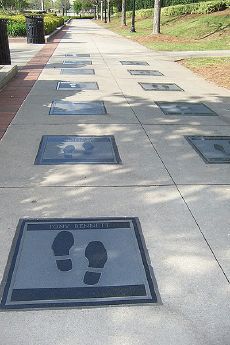
Also in 1962, Bennett released his recording of "I Left My Heart in San Francisco", a decade-old but little-known song originally written for an opera singer. Although this single only reached number 19 on the Billboard Hot 100, it spent close to a year on various other charts and increased Bennett's exposure. The album of the same title was a top 5 hit and both the single and album achieved gold record status.[19] The song won Grammy Awards for Record of the Year and Best Male Solo Vocal Performance for Bennett. Over the years, this would become known as Bennett's signature song.[9][20] In 2001, it was ranked 23rd on an RIAA/NEA list of the most historically significant Songs of the 20th Century.
Bennett's following album, I Wanna Be Around... (1963), was also a top-5 success, with the title track and "The Good Life" each reaching the top 20 of the pop singles chart[24] along with the top 10 of the Adult Contemporary chart.
The next year brought the Beatles and the British Invasion, and with them still more musical and cultural attention to rock and less to pop, standards, and jazz. Over the next couple of years, Bennett had minor hits with several albums and singles based on show tunes; his last top-40 single was the number 34 "If I Ruled the World" from the musical Pickwick in 1965,[24] but his commercial fortunes were clearly starting to decline. An attempt to break into acting with a role in the poorly received 1966 film The Oscar met with middling reviews for Bennett; he did not enjoy the experience and did not seek further roles.[1]
A firm believer in the Civil Rights Movement, Bennett participated in the 1965 Selma to Montgomery marches. He performed in the "Stars for Freedom" rally the night before Martin Luther King's "How Long, Not Long" speech. At the conclusion of the march, Bennett was driven to the airport by Viola Liuzzo, a mother of five from Detroit, who was murdered later that day by the Ku Klux Klan.[27]
Bennett refused to perform in apartheid South Africa.[9]
1965–1979: Years of struggle
Ralph Sharon and Bennett parted ways in 1965. There was great pressure on singers such as Lena Horne and Barbra Streisand to record "contemporary" rock songs and, in this vein, Columbia Records' Clive Davis suggested that Bennett do the same. Bennett was very reluctant and, when he tried, the results pleased no one. This was exemplified by Tony Sings the Great Hits of Today! (1970),[19] which featured covers of Beatles and other current songs and a psychedelic art cover and Bennett became physically ill at the thought of recording it.[28]
Years later, Bennett would recall his dismay at being asked to do contemporary material, comparing it to when his mother was forced to produce a cheap dress.[1] By 1972, he had departed Columbia for the Verve division of MGM Records (Philips in the UK) and relocated for a stint in London, where he hosted a television show from the Talk of the Town nightclub in conjunction with Thames Television, Tony Bennett at the Talk of the Town.[2] With his new label, he tried a variety of approaches, including some more Beatles material, but found no renewed commercial success, and in a couple more years he was without a recording contract.
Taking matters into his own hands, Bennett started his own record company, Improv.[19] He recorded some songs that would later become favorites, such as "What is This Thing Called Love?" and made two well-regarded albums with jazz pianist Bill Evans, The Tony Bennett/Bill Evans Album (1975) and Together Again (1976), but Improv lacked a distribution arrangement with a major label and by 1977, it was out of business.[19]
As the decade neared its end, Bennett had no recording contract, no manager, and was not performing many concerts outside of Las Vegas.[29] He had developed a drug addiction, was living beyond his means, and had the Internal Revenue Service trying to seize his Los Angeles home.[30]
1979–1989: Turnaround
After a near-fatal cocaine overdose in 1979, Bennett called his sons Danny and Dae for help. "Look, I'm lost here," he told them. "It seems like people don't want to hear the music I make."[29]
Danny and Dae's band, Quacky Duck and His Barnyard Friends, had foundered and the former realized he was not musically talented but had a head for business. His father, on the other hand, had tremendous musical talent, but had trouble sustaining a career from it and had little financial sense. Danny signed on as his father's manager.[30]
Danny got his father's expenses under control, moved him back to New York City, and began booking him in colleges and small theaters to get him away from a "Vegas" image.[29] After some effort, a successful plan to pay back the IRS debt was put into place.[30] The singer had also reunited with Ralph Sharon as his pianist and musical director (and would remain with him until Sharon's retirement in 2002).[31] By 1986, Tony Bennett was re-signed to Columbia Records, this time with creative control, and released The Art of Excellence. This became his first album to reach the charts since 1972.[19]
1990–2006: Established career
Danny Bennett felt that younger audiences who were unfamiliar with his father would respond to his music if given a chance.[32] No changes to Tony's formal appearance, singing style, musical accompaniment (The Ralph Sharon Trio or an orchestra), or song choice (generally the Great American Songbook) were necessary or desirable.[19] Accordingly, Danny began regularly to book his father on Late Night with David Letterman, a show with a younger, "hip" audience.[32] This was subsequently followed by appearances on Late Night with Conan O'Brien, Sesame Street, The Simpsons, Muppets Tonight, and various MTV programs.[9] In 1993, Bennett played a series of benefit concerts organized by alternative rock radio stations around the country.[32] The plan worked; as Tony later remembered, "I realized that young people had never heard those songs. Cole Porter, Gershwin—they were like, 'Who wrote that?' To them, it was different. If you're different, you stand out."[29]
During this time, Bennett continued to record, first putting out the acclaimed look-back Astoria: Portrait of the Artist (1990), then emphasizing themed albums such as the Sinatra homage Perfectly Frank (1992) and the Fred Astaire tribute Steppin' Out (1993). The latter two both achieved gold status and won Grammys for Best Traditional Pop Vocal Performance (Bennett's first Grammys since 1962) and further established Bennett as the inheritor of the mantle of a classic American great.[32]
As Bennett was seen at MTV Video Music Awards shows side by side with the likes of the Red Hot Chili Peppers and Flavor Flav, and as his "Steppin' Out with My Baby" video received MTV airplay, it was clear that, as The New York Times said, "Tony Bennett has not just bridged the generation gap, he has demolished it. He has solidly connected with a younger crowd weaned on rock. And there have been no compromises."[33]
The new audience reached its height with Bennett's appearance in 1994 on MTV Unplugged.[30] He quipped on the show, "I've been unplugged my whole career." Featuring guest appearances by rock and country stars Elvis Costello and k.d. lang (both of whom had an affinity for the standards genre), the show attracted a considerable audience and much media attention.[32] The resulting MTV Unplugged: Tony Bennett album went platinum and, besides taking the Best Traditional Pop Vocal Performance Grammy award for the third straight year, also won the top Grammy prize of Album of the Year.[4]
Following his comeback, Bennett financially prospered. He had no intention of retiring, saying in reference to masters such as Pablo Picasso, Jack Benny, and Fred Astaire: "right up to the day they died, they were performing. If you are creative, you get busier as you get older."[30] He continued to record and tour steadily, playing a hundred shows a year by the end of the 1990s. In concert, he often made a point of singing one song (usually "Fly Me to the Moon") without any microphone or amplification, demonstrating his skills at vocal projection.[34] One show, Tony Bennett's Wonderful World: Live From San Francisco, was made into a PBS special. He conceptualized and starred in the first episode of the A&E Network's popular Live by Request series, for which he won an Emmy Award.[30]
In 1998, Bennett performed on the final day of a mud-soaked Glastonbury Festival in an immaculate suit and tie,[35] his whole set on this occasion consisting of songs about the weather. His autobiography The Good Life was also first published in 1998.
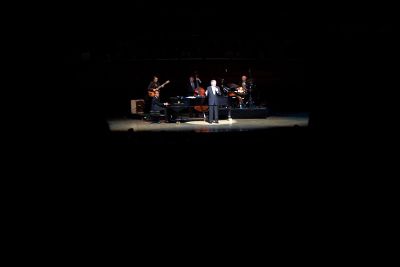
2006–2021: Later years
On August 3, 2006, Bennett turned 80 years old, and his advancing age had little impact on his career as he continued recording and performing frequently and successfully. His record label celebrated by releasing reissues, compilations, and the album Duets: An American Classic, which reached his highest chart position ever and won a Grammy Award.[19] Concerts were given, including a high-profile one for New York radio station WLTW/106.7; a performance with Christina Aguilera, and a comedy sketch with affectionate Bennett impressionist Alec Baldwin on Saturday Night Live; a Thanksgiving-time, Rob Marshall-directed television special Tony Bennett: An American Classic on NBC, which went on to win multiple Emmy Awards;[22] receipt of the Billboard Century Award;[36] and guest-mentoring on American Idol as well as performing during its finale. He also received the United Nations High Commissioner for Refugees' Humanitarian Award, and the National Endowment for the Arts Jazz Masters Award in 2006.[36]
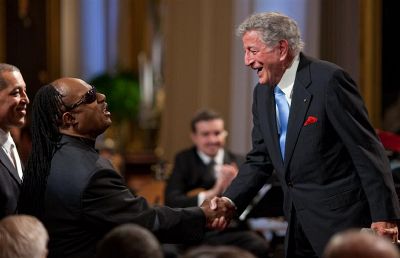
In 2008, Bennett made two appearances with Billy Joel singing "New York State of Mind" at the final concerts given at Shea Stadium, and in October released the album A Swingin' Christmas with The Count Basie Big Band, for which he made a number of promotional appearances at holiday time. In 2009, Bennett performed at the conclusion of the final Macworld Conference & Expo for Apple Inc., singing "The Best Is Yet to Come" and "I Left My Heart In San Francisco" to a standing ovation, and later making his Jazz Fest debut in New Orleans. In February 2010, Bennett was one of over 70 artists who sang on "We Are the World 25 for Haiti," a charity single in aid of the 2010 Haiti earthquake.[37] In October, he performed "I Left My Heart in San Francisco" at AT&T Park before the third inning of Game 1 of the 2010 World Series and sang "God Bless America" during the seventh-inning stretch. Days later he sang "America the Beautiful" at the Rally to Restore Sanity and/or Fear in Washington, D.C., which he reprised ten years later in a segment on The Late Show with Stephen Colbert.[38]
In September 2011, Bennett released Duets II, a follow-up to his first collaboration album, in conjunction with his 85th birthday. He sang duets with seventeen prominent singers including Aretha Franklin, Willie Nelson, Queen Latifah, and Lady Gaga.[39] His duet with Amy Winehouse on "Body and Soul"—reportedly the last recording she made before her death[40]—charted on the lower reaches of the Billboard Hot 100, making Bennett the oldest living artist to appear there, as well as the artist with the greatest span of appearances.[41] The single did well in Europe, where it reached the top 15 in several countries. The album then debuted at number one on the Billboard 200, making Bennett the oldest living artist to reach that top spot, as well as marking the first time he had reached it himself.[42]
In November 2011, Columbia released Tony Bennett – The Complete Collection, a 73-CD plus 3-DVD set, which although not absolutely "complete," brought forth many albums that had not had a previous CD release, as well as some unreleased material and rarities. In December 2011, Bennett appeared at the Royal Variety Performance in Salford in the presence of Princess Anne.[43]
In October 2012, Bennett released Viva Duets, an album of Latin American music duets, featuring Vicente Fernández, Juan Luis Guerra, and Vicentico among others. On October 31, 2012, Bennett performed "I Left My Heart in San Francisco" in front of more than 100,000 fans at a City Hall ceremony commemorating the 2012 World Series victory by the San Francisco Giants. He published another memoir, Life is a Gift: The Zen of Bennett,[44] and a documentary film produced by his son Danny was released, also titled The Zen of Bennett.[45]
In September 2014, Bennett performed for the first time in Israel, with his jazz quartet at the Charles Bronfman Auditorium in Tel Aviv, receiving a standing ovation. He also made a surprise cameo appearance on stage with Lady Gaga at Hayarkon Park, Tel Aviv, the previous evening. The performance took place days before the release that month of the two stars' much-delayed collaborative effort and resultant Grammy-winning album, Cheek to Cheek, which debuted at number one on the Billboard charts, extending the 88-year-old Bennett's record for the oldest artist to do so,[46] which earned him the Guinness World Records for "oldest person to reach No.1 on the US Album Chart with a newly recorded album," at the age of 88 years and 69 days.[47] In October 2014, Bennett and Lady Gaga released the concert special Tony Bennett and Lady Gaga: Cheek to Cheek Live!, and at the end of the year, they kicked off their co-headlining Cheek to Cheek Tour.
On September 25, 2015, he released an album of songs composed by Jerome Kern, featuring Bill Charlap on piano, called The Silver Lining: The Songs of Jerome Kern. On November 1, 2015, Bennett, joined by the choir from the Frank Sinatra School, sang "America the Beautiful" before Game 5 of the baseball World Series between the Kansas City Royals and New York Mets at Citi Field.
On August 19, 2016, shortly after his 90th birthday, Bennett was honored by the unveiling of an 8-foot tall statue in his likeness in front of the Fairmont Hotel in San Francisco. With Senator Dianne Feinstein, House Minority Leader Nancy Pelosi, and several San Francisco mayors in attendance, Bennett was serenaded by a young-adult choir singing "I Left My Heart in San Francisco." Bennett had first sung the song at the hotel in 1961. That same year, he performed at the Macy's Thanksgiving Day Parade on November 24 and the Rockefeller Center tree lighting on November 30. On December 20, 2016, NBC televised a special concert in honor of his 90th birthday, called Tony Bennett Celebrates 90: The Best Is Yet to Come. In September 2018, Bennett re-recorded the George Gershwin song "Fascinating Rhythm", after 68 years and 342 days, according to the Guinness World Records adjudicator, earning the title of "longest time between the release of an original recording and a re-recording of the same single by the same artist."[48] The song appeared on the collaborative album Love Is Here to Stay with Diana Krall that was released on September 14.
Bennett's final album, Love for Sale, another collaborative record with Lady Gaga, was released on September 30, 2021. The record debuted at number eight in the United States; Bennett broke the individual record for the longest span of top-10 albums on the Billboard 200 chart for any living artist; his first top-10 record was I Left My Heart in San Francisco in 1962. Alexis Petridis called Bennett's performance on the album "pretty remarkable" despite the singer's age and health condition in his review for The Guardian.[49] Bennett also broke the Guinness World Record for the oldest person to release an album of new material, at the age of 95 years and 60 days.[50]
Bennett's final live performances were on August 3 and 5, 2021, when he presented a pair of shows with Lady Gaga at Radio City Music Hall. On August 12, 2021, nine days after his 95th birthday, Bennett's retirement from concerts was announced by his son and manager Danny Bennett. Danny stated that though his father remained a capable singer, he was becoming physically frail and risked a major fall if he continued touring.[51] A television special, One Last Time: An Evening with Tony Bennett and Lady Gaga debuted on November 28, 2021, on CBS, which contained select performances from the two final concerts.[52] Bennett's last televised performance was also with Gaga on December 16, 2021, on MTV Unplugged. The special was filmed the previous July in front of an intimate studio audience in New York City, and included duets from Love for Sale.[53]
Painter
Bennett followed up his childhood interest in painting with professional training, work, and museum visits throughout his life. He had success as a painter, done under his real name of Anthony Benedetto, or just Benedetto.[54] He sketched or painted every day, often of views out of hotel windows when he was on tour.[36]
He exhibited his work in numerous galleries around the world. He was chosen as the official artist for the 2001 Kentucky Derby, and was commissioned by the United Nations to do two paintings, including one for its fiftieth anniversary.[36] His painting Homage to Hockney (for his friend David Hockney, painted after Hockney drew him) is on permanent display at the Butler Institute of American Art in Youngstown, Ohio.[54] His Boy on Sailboat, Sydney Bay is in the permanent collection at the National Arts Club on Gramercy Park in New York City, as is his Central Park at the Smithsonian American Art Museum in Washington, D.C.[36] His paintings and drawings have been featured in ARTnews and other magazines, and have sold for as much as $80,000 a piece.[9][30] Many of his works were published in the art book Tony Bennett: What My Heart Has Seen in 1996.[55] In 2007, another book involving his paintings, Tony Bennett in the Studio: A Life of Art & Music, became a best-seller among art books.[22]
Awards and legacy
Bennett won 19 Grammy Awards plus the Grammy Lifetime Achievement Award which he was awarded in 2001.[56] He was hailed as the "champion" and "legendary interpreter" of the Great American Songbook.[57]
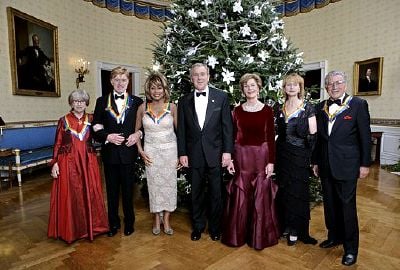
Regarding his choices in music, Bennett reiterated his artistic stance in a 2010 interview:
I'm not staying contemporary for the big record companies, I don't follow the latest fashions. I never sing a song that's badly written. In the 1920s and '30s, there was a renaissance in music that was the equivalent of the artistic Renaissance. Cole Porter, Johnny Mercer and others just created the best songs that had ever been written. These are classics, and finally they're not being treated as light entertainment. This is classical music.[58]
For his contribution to the recording industry, Bennett was given a star on the Hollywood Walk of Fame at 1560 Vine Street.[59] Bennett was inducted into the Big Band and Jazz Hall of Fame in 1997, and received a lifetime achievement award from the American Society of Composers, Authors and Publishers (ASCAP) in 2002. On December 4, 2005, Bennett was the recipient of a Kennedy Center Honor.[36] Later, a theatrical musical revue of his songs, called I Left My Heart: A Salute to the Music of Tony Bennett was created and featured some of his best-known songs such as "I Left My Heart in San Francisco," "Because of You," and "Wonderful."[60]
Upon hearing of his death, numerous stars reacted with words of praise and respect for Tony Bennett, for his contributions to music and to making the world a better place, including:
“Without doubt the classiest singer, man, and performer you will ever see. He’s irreplaceable. I loved and adored him.” — Sir Elton John
“I love being able to take lessons from someone like Tony. And one of the great lessons, I think, is to be strong in the conviction of who you are and strong enough to stay true to that because tastes change, times change. But if you know what you’re doing and you have confidence in that and integrity, the world will find you. — Michael Bublé.
“Goodnight, Tony Bennett. Thank you for your commitment to love, civil rights, and a better world. ... a national and global treasure who utilized his platform as a legendary performer to stand for Civil Rights.” — Bernice King, daughter of Martin Luther King Jr.
“Tony was one of the most splendid people who ever lived. Kind, loving, talented and generous, he never let us down. ... Tony was a true champion.” — Nancy Sinatra
“Rest in peace, Tony. You were the epitome of a gentleman with a God given one-of-a-kind voice. It was truly a great honor of my career and of my life to get to share the stage with you…” — Carrie Underwood, duet partner on “It Had to Be You”
“His was a unique voice that made the transition from the era of Jazz into the age of Pop. I will always be grateful for his outstanding contribution to the art of contemporary music. He was a joy to work with. His energy and enthusiasm for the material he was performing was infectious. He was also one of the nicest human beings I’ve ever known.” — Billy Joel
“Tony Bennett was a consummate artist. All you have to do is listen to any one of his hundreds of recordings to recognize that. Very early on, his music quietly wove itself into the fabric of our lives. His voice felt as familiar and as close as the voices of our loved ones. I know that this was true for millions of people around the world. For Italian-Americans who were growing up in the middle of the twentieth century, that familiarity ran even deeper. At a certain point, we started to imagine that Tony would live forever. Of course he didn’t. Nobody does. But the music? That’s another story.” — Martin Scorsese[38]
Notes
- ↑ 1.0 1.1 1.2 1.3 1.4 1.5 1.6 1.7 1.8 Tony Bennett, The Good Life (Simon & Schuster, 1999, ISBN 978-0671029586).
- ↑ 2.00 2.01 2.02 2.03 2.04 2.05 2.06 2.07 2.08 2.09 2.10 David Evanier, All the Things You Are: The Life of Tony Bennett (Trade Paper Press, 2011, ISBN 978-1630269210).
- ↑ 3.0 3.1 3.2 3.3 3.4 3.5 3.6 Robert Sullivan, Tony Bennett: The musician and the artist Today (September 24, 2007). Retrieved September 6, 2023.
- ↑ 4.0 4.1 4.2 4.3 4.4 Greg Fitzgerald, Jazz Profiles: Tony Bennett NPR. Retrieved September 6, 2023.
- ↑ 5.0 5.1 5.2 Deborah Apton, Nightline Playlist: Tony Bennett ABC News (September 27, 2007). Retrieved September 7, 2023.
- ↑ Brian Canova, Tony Bennett on 9/11 Attacks: 'They Flew the Plane in, But We Caused It' ABC News (September 19, 2011). Retrieved September 7, 2023.
- ↑ Liz Fields, The time Tony Bennett “…saw things no human being should ever have to see.” American Masters (February 16, 2021). Retrieved September 7, 2023.
- ↑ 8.0 8.1 8.2 8.3 Joe Mosbrook, Tony Bennett's Cleveland Connections Jazzed in Cleveland (November 28, 2001). Retrieved September 9, 2023.
- ↑ 9.0 9.1 9.2 9.3 9.4 9.5 He keeps coming back like a song Good Housekeeping (April 1, 1995). Retrieved September 7, 2023.
- ↑ Tony Bennett's Estranged Wife Seeks Divorce United Press International (October 3, 1969). Retrieved September 8, 2023.
- ↑ Tony Bennett, suave singer of I Left My Heart in San Francisco whose career spanned 70 years – obituary The Daily Telegraph (July 21, 2023). Retrieved September 8, 2023.
- ↑ Effie Orfanides, Susan Benedetto, Tony Bennett's Wife: 5 Fast Facts You Need to Know Heavy (January 13, 2018). Retrieved September 8, 2023.
- ↑ Ulrica Wihlborg, Tony Bennett Marries His (Very) Longtime Love People (December 1, 2020). Retrieved September 8, 2023.
- ↑ 14.0 14.1 Mark Savage, Tony Bennett reveals he has Alzheimer's BBC News (February 1, 2020). Retrieved September 8, 2023.
- ↑ Jen Juneau, Tony Bennett Still Practices Performing Twice a Week amid Alzheimer's Diagnosis People (February 1, 2021). Retrieved September 8, 2023.
- ↑ Tony Bennett: Legendary singer retires from stage aged 95 BBC News (August 13, 2021). Retrieved September 8, 2023.
- ↑ Paul Glynn and Steven McIntosh, Tony Bennett: Legendary singer dies aged 96 BBC News (July 21, 2023). Retrieved September 8, 2023.
- ↑ Peter C. Mastrosimone, Tony Bennett buried in Calvary Cemetery Queens Chronicle (August 17, 2023). Retrieved September 8, 2023.
- ↑ 19.0 19.1 19.2 19.3 19.4 19.5 19.6 19.7 19.8 Stephen Thomas Erlewine, Tony Bennett: Biography AllMusic. Retrieved September 9, 2023.
- ↑ 20.0 20.1 20.2 Clint Eastwood tells Tony Bennett's story for 'American Masters' Associated Press (September 7, 2007). Retrieved September 9, 2023.
- ↑ Roseanna Vitro, Tony Bennett: His Life in Art & Song Jazz Times (April 26, 2019). Retrieved September 7, 2023.
- ↑ 22.0 22.1 22.2 Todd Leopold, Tony Bennett remains true to standards CNN (October 18, 2007). Retrieved September 9, 2023.
- ↑ Neil Cossar, This Day in Music: An Everyday Record of 10,000 Musical Facts (Collins & Brown, 2005, ISBN 978-1843402985).
- ↑ 24.0 24.1 24.2 Joel Whitburn, The Billboard Book of Top 40 Hits (BPI Communications, 2000, ISBN 978-0823076901).
- ↑ Tim Brooks and Earle F. Marsh, The Complete Directory to Prime Time Network and Cable TV Shows, 1946-present (Ballantine Books, 2007, ISBN 978-0345497734).
- ↑ Alex McNeil, Total Television: A Comprehensive Guide to Programming from 1948 to the Present (Penguin Books, 1991, ISBN 0140157360).
- ↑ Bruce Weber, Tony Bennett, Champion of the Great American Songbook, Is Dead at 96 The New York Times (July 21, 2023). Retrieved September 9, 2023.
- ↑ Will Friedwald, Jazz Singing (Da Capo Press, 1996, ISBN 978-0306807121).
- ↑ 29.0 29.1 29.2 29.3 John Lewis, Tony Bennett AARP Magazine (July-August 2003 ). Retrieved September 9, 2023.
- ↑ 30.0 30.1 30.2 30.3 30.4 30.5 30.6 Geraldine Fabrikant, Talking Money With: Tony Bennett: His Heart's in San Francisco, His Money in His Son's Hands The New York Times (May 2, 1999). Retrieved September 9, 2023.
- ↑ Margalit Fox, Ralph Sharon, 91, Tony Bennett's Pianist The New York Times (April 7, 2015). Retrieved September 9, 2023.
- ↑ 32.0 32.1 32.2 32.3 32.4 John Marchese When He Croons, Slackers Listen The New York Times (May 1, 1994). Retrieved September 10, 2023.
- ↑ John J. O'Connor, Tony Bennett and MTV: Talk About Bedfellows The New York Times (June 1, 1994). Retrieved September 10, 2023.
- ↑ Patrick Macdonald, A Touch Of Class From Tony Bennett The Seattle Times (September 2, 1991). Retrieved September 10, 2023.
- ↑ History 1998 Glastonbury Festival. Retrieved September 10, 2023.
- ↑ 36.0 36.1 36.2 36.3 36.4 36.5 Tony Bennett: The Music Never Ends American Masters, September 12, 2007. Retrieved September 11, 2023.
- ↑ Alan Duke, Stars gather for 'We Are the World' recordingCNN (February 2, 2010). Retrieved September 11, 2023.
- ↑ 38.0 38.1 Friends and admirers of Tony Bennett react to the news of his death Associated Press (July 21, 2023). Retrieved September 11, 2023.
- ↑ Gay Talese, High Notes: Tony Bennett in the studio – with Lady Gaga The New Yorker (September 12, 2011). Retrieved September 11, 2023.
- ↑ David Burger, Amy Winehouse the highlight of Tony Bennett's 'Duets II' The Salt Lake Tribune (September 26, 2011). Retrieved September 11, 2023.
- ↑ Gary Trust, Tony Bennett Oldest Living Artist Ever On Hot 100 Billboard (September 21, 2011). Retrieved September 11, 2023.
- ↑ Keith Caulfield, Tony Bennett, 85, Achieves First No. 1 Album on Billboard 200 Billboard (September 28, 2011). Retrieved September 11, 2023.
- ↑ Salford's Lowry hosts Royal Variety Performance BBC (December 5, 2011). Retrieved September 11, 2023.
- ↑ Tony Bennett, Life Is a Gift: The Zen of Bennett (Harper, 2012, ISBN 978-0062207067).
- ↑ The Zen of Bennett (2012) IMDb. Retrieved September 11, 2023.
- ↑ Randy Lewis, Tony Bennett-Lady Gaga's 'Cheek to Cheek' reaches No. 1 Los Angeles Times (October 1, 2014). Retrieved September 11, 2023.
- ↑ Oldest person to reach No.1 on the US album chart with a newly recorded album Guinness World Records (October 11, 2014). Retrieved September 11, 2023.
- ↑ Raisa Bruner, Tony Bennett Just Locked Down a Very Obscure Guinness Record TIME (September 13, 2018). Retrieved September 11, 2023.
- ↑ Alexis Petridis, Lady Gaga and Tony Bennett: Love for Sale review – jazz interloper livens up crooner's swan song The Guardian (September 30, 2021). Retrieved September 11, 2023.
- ↑ Amanda Marcus, Legendary Tony Bennett officially the oldest person to release an album of new material Guinness World Records (October 8, 2021). Retrieved September 11, 2023.
- ↑ A.D. Amorosi, Tony Bennett's Son, Danny, on Why the Legend's Radio City Music Hall Shows Went So Well — and Why There Won't Be More Variety (August 12, 2021). Retrieved September 10, 2023.
- ↑ Chris Willman, Tony Bennett and Lady Gaga Partner With ViacomCBS for Three Specials, to Air on CBS, MTV and Paramount Plus Variety (September 15, 2021). Retrieved September 10, 2023.
- ↑ Liz Calvario, Lady Gaga and Tony Bennet Are a Class Act in Final Televised Performance Together for 'MTV Unplugged' ET (December 17, 2021). Retrieved September 10, 2023.
- ↑ 54.0 54.1 Tony Bennett The Kennedy Center. Retrieved September 11, 2023.
- ↑ Tony Bennett, Tony Bennett: What My Heart Has Seen (Rizzoli, 1996, ISBN 978-0847819720).
- ↑ Tony Bennett Recording Academy. Retrieved September 11, 2023.
- ↑ Phil Gallo, Tony Bennett, Legendary Interpreter of Great American Songbook, Dies at 96 The New York Times (July 21, 2023). Retrieved September 8, 2023.
- ↑ Tim Clodfelter, Star Performer: Tony Bennett says a key to his continued success is being true to the audience Winston-Salem Journal (April 9, 1919). Retrieved September 11, 2023.
- ↑ Tony Bennett Hollywood Walk of Fame. Retrieved September 11, 2023.
- ↑ I Left My Heart, A Salute to the Music of Tony Bennett Summer Wind Productions. Retrieved September 11, 2023.
ReferencesISBN links support NWE through referral fees
- Bennett, Tony. Tony Bennett: What My Heart Has Seen. Rizzoli, 1996. ISBN 978-0847819720
- Bennett, Tony. The Good Life. Simon & Schuster, 1999. ISBN 978-0671029586
- Bennett, Tony. Life Is a Gift: The Zen of Bennett. Harper, 2012. ISBN 978-0062207067
- Bennett, Tony, and Dick Golden. Tony Bennett Onstage and in the Studio. Union Square & Co., 2018. ISBN 978-1454931249
- Bennett, Tony, and Scott Simon. Just Getting Started . Harper, 2016. ISBN 978-0062476777
- Bennett, Tony, and Robert Sullivan. Tony Bennett in the Studio: A Life of Art & Music. Union Square & Co., 2007. ISBN 978-1402747670
- Brooks, Tim, and Earle F. Marsh. The Complete Directory to Prime Time Network and Cable TV Shows, 1946-present. Ballantine Books, 2007. ISBN 978-0345497734
- Cossar, Neil. This Day in Music: An Everyday Record of 10,000 Musical Facts. Collins & Brown, 2005. ISBN 978-1843402985
- Evanier, David. All the Things You Are: The Life of Tony Bennett. Trade Paper Press, 2011. ISBN 978-1630269210
- McNeil, Alex. Total Television: A Comprehensive Guide to Programming from 1948 to the Present. Penguin Books, 1991. ISBN 0140157360
- Whitburn, Joel. The Billboard Book of Top 40 Hits. BPI Communications, 2000. ISBN 978-0823076901
External links
All links retrieved September 12, 2023.
- Tony Bennett
- Tony Bennett Interview NAMM Oral History Collection (1986)
- Tony Bennett AllMusic
- Tony Bennett (1926-2023) IMDb
| |||||||||||||||||||||||
Credits
New World Encyclopedia writers and editors rewrote and completed the Wikipedia article in accordance with New World Encyclopedia standards. This article abides by terms of the Creative Commons CC-by-sa 3.0 License (CC-by-sa), which may be used and disseminated with proper attribution. Credit is due under the terms of this license that can reference both the New World Encyclopedia contributors and the selfless volunteer contributors of the Wikimedia Foundation. To cite this article click here for a list of acceptable citing formats.The history of earlier contributions by wikipedians is accessible to researchers here:
The history of this article since it was imported to New World Encyclopedia:
Note: Some restrictions may apply to use of individual images which are separately licensed.
